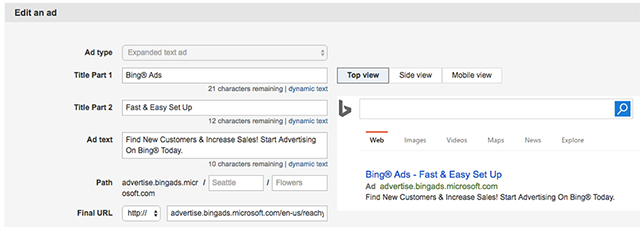Just a few short months ago, Google announced expanded text ads. At first, there was a little panic in the advertising world. But now that it is rolled out to everyone, marketers are jumping on board and realizing the new norm. Now that expanded text ads have been fully released to all AdWords accounts and the initial shock is over, what now?
Bing!
Shortly after Google formally announced expanded text ads would be coming to AdWords, Bing said it would add support for the new longer text ad format. On Tuesday, Bing Ads began accepting advertisers into a pilot for ETAs.
To get into the test, you’ll need to provide contact information and customer IDs in an application form. Bing Ads is also surveying advertisers about whether they “have any concerns or open questions with expanded text ads.”
According to the application notes, it may take up to a week to get ETAs activated in your account after signing up. “Customers with pilot access will be able to sync AdWords campaigns using Expanded Text Ads to Bing Ads using Google Import in addition to manag[ing] Expanded Text Ads using Bing Ads Web UI and Bing Ads Editor and Bing Ads API,” explains Jamie Chung, Bing Ads program manager, in the pilot announcement.
Here is a snapshot of what the interface will look like while editing an expanded ad.

Now that expanded text ads have rolled out to both platforms, it is important that you evaluate your efforts thus far in order to start Bing on its best path.
Depending on when you were granted access to this new ad type in AdWords and Bing, you may be in one of the three stages of implementation.
- Planning when is the optimal time to roll creative out.
- Determining your creative with a purpose in mind.
- Analyzing and optimizing creative that has been running.
Here are some ways you can optimize according to which stage you are in and how to roll them over to Bing.
1) How And When To Make The Full ETA Shift
When Google officially launched expanded text ads, they noted that standard ads would no longer be accepted or editable as of October 26, 2016. So, do it before then! Easy enough… well, maybe a little more info would be helpful?
Before the full switch happens in AdWords, create a schedule of when you will be rolling the ETA’s out to each campaign and/or ad group. If you have a large account, it may take a few weeks. Take that time to gather information and make changes along the way. Knowing that, it would be best to start with the bottom 10-20% of your ad groups. That way as you are working your way up to your best-performing ad groups, and they are benefiting from the knowledge that you have gained.
If you have mirrored AdWords campaigns in Bing, keep them updated with ETAs along they way, but make sure you evaluate their performance separately. At this point, we all know that Google and Bing perform differently. So if you have set ad testing strategies that you know to work well in your account for the individual platforms, stick to that strategy.
Unfortunately, there is no standard answer here on a rollout schedule for expanded text ads because accounts vary so much. If your existing standard ads possess history and good relevance, your best bet may be to use ETAs sparingly in the coming two months. The same logic applies especially for Bing, as we don’t have a strict timeline to retire standard ads.
Does that mean you shouldn’t run ETAs at all? No, they should be in every ad group. Just don’t dive in fully without testing first. Keep in mind that this change is coming, and plan accordingly.
2) Have A Purpose For Your Creative
A mistake that can happen so easily is advertisers just getting the ETAs done and out of the way. At this point, if you don’t have them up yet, take your time and do it right.
The use of similar ad copy and character counts in a new format won’t bring incremental clicks. Change your ETA ad copy to generate additional value from the newly existing space. If you just reuse existing headlines or fill in old ad copy to take up space, it is not an effective use of the new features.
As an example of what you can include, headline 1 can introduce concepts or align with the search terms used. Headline 2 may use numbers to draw the attention of the searcher. The description line should educate and inform as this text is more of an afterthought for them to read. Path 1 may tell the user this URL is relevant to their search and finally, path 2 may by best used as a call to action. This messaging should be unique to your brand and your clients’ needs.
3) Iterate To Make ETAs Most Effective
New copy is always a challenge. Testing the new variables related to expanded text ads is unmapped territory for all of us. Now that they are rolling over to Bing we need to be extra efficient.
If at this point you’ve implemented new AdWords ETAs, it is time to collect data and evolve your creative testing plan. Then, roll those ads over to Bing knowing you’ve made the best effort possible to start them out strong.
Review “new creative” performance data (impressions, clicks, conversions, sales) against existing standard ads. You should be doing this every two to four weeks depending on volume. Then, evaluate the impact of what you’ve learned. You may have some idea of what your testing plan looks like, but ad testing is an ever-evolving system. Your previous tests should change your future tests and so on.
Now carry those learnings over to Bing ETAs and start gathering performance data and learning about the kind of optimizations that Bing will push us to evaluate. Bing can show different performance from AdWords so it will be a whole new learning experience and creative process.



